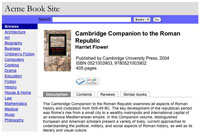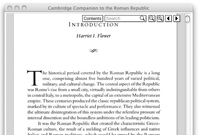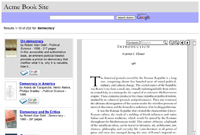The APIs in the Google Books API Family are available to anyone wishing to integrate with Google Books from their own site or application. No pre-approval is needed to use these APIs.
Use of these APIs is, however, governed by the Terms of Service. Among other things, these Terms require that you adhere to certain guidelines on how layout, Google attribution, and branding must be handled on your site. This document is intended to help you meet these requirements.
These branding guidelines may change from time to time, and without prior notice from Google. Your continued use of the Google Books API Family is contingent upon your adherence to the current branding guidelines. If you are uncomfortable with any of these branding guidelines, discontinue your use of the APIs, and contact us with your concerns.
Overview
The purpose of the Google Books API Family is to help you reliably direct users to Google Books services from your site. Accordingly, there are certain attribution and linking requirements. The following basic principles govern your use of the Google Books API Family:
- Adherence to these guidelines is required prior to use of the Google Books API Family from your website or application.
- You must adhere to certain naming conventions associated with Google Books and its features.
- Google must be given attribution, using the appropriate text or brand elements, whenever you display Google results, previews, or other content made available through the API.
- You must maintain prominent links to Google Books pages and features.
- You must not alter results or content made available through the Google Books API Family.
Naming
To help us ensure a consistent end-user experience and accurate expectation of Google Books features, you must abide by certain naming conventions.
When creating a feature or product utilizing the Google Books API Family, the name of the feature or product cannot use Google, Google Books, or other Google Brand Features in the name of the software or feature. If for marketing or other strategic reasons it would valuable to have Google Books referenced, it may be permissible for the developer to use the phrase (e.g., 'Acme Plugin for Google Books,' but never 'Google Books AcmeOPAC Plugin'), however this should be the exception and not the rule. You may not state or otherwise imply any affiliation with Google or Google Books.
It may occasionally be necessary to refer to Google Books or features provided through these APIs (e.g., in documentation, headers, buttons, and so on). When doing so, you must only use approved terminology:
- Google Books service: Use only the term "Google Books" to refer the service made available through these APIs and at URLs such as books.google.com. Do not modify this word mark, for example, through hyphenation, combination abbreviation, or acronym such as: Google-Books, GB, Google Book Search, etc.
- Google Books API Family: Use only the term "Google Books API Family" to refer to the set of developer-facing features described at https://developer.google.com/books. Refer to specific APIs and tools using the terminology from this site.
- Preview capabilities: If you refer to Google-provided book preview capabilities in your application (e.g., in headers or explanatory text), use only one of the following terms, and do so consistently throughout your site: "Preview," "Google Preview," or "Book preview." When referring to viewability levels, use only the terms "Limited preview" or "Full view."
- Search capabilities: You may only use the verbs "Search," "Search Books," or "Search in this book" when prompting users for action that results in an API query (e.g., on a form 'submit' button). Use only the term "Google Books search results" in conjunction with the display of search results from this API.
- User-generated content: Some of the APIs in the Google Books API Family allow you to read and write user-generated content including reviews and book collections. Refer to these features according to the terminology on Google Books and related documentation. For example: you may use "My Library" (not Google Library), "labels" (not tags), "reviews," "ratings," and so on.
If you wish to refer to Google Books features in a language other than English, you must do so using the same terminology as the Google Books site, which is available in over 35 languages. For convenience, we provide a table of approved translations for some of the the most common features.
For additional questions about other uses of Google Brand Features, please see https://www.google.com/permissions/guidelines.html.
Attribution and logos
In addition to following Google's general Brand Features guidelines, you are also required to adopt certain branding elements when using the Google Books API Family. These forms of attribution are used in order to maintain consistency and preserve the Google brand identity.
The following basic principles govern use of the Google name and logo in conjunction with the Google Books API Family:
- Google attribution is required.
- The Google name and logo should be associated with Google Books only.
- The Google logo may never appear next to or on the same page with the logos of competing web or other search services. There are no exceptions to this rule.
- The "powered by Google" graphic must always be displayed alongside any search modules or results.
- You shall display any and all intellectual property rights legends and notices (e.g., copyright notices) as instructed by Google.
The following sections provide more detail on acceptable attribution.
Book previews
Whenever you wish to direct users to a page or element whose most prominent element is the Google-provided book preview ("Google Preview"), you must link to that page using the authorized, clickable "Google Preview" button below. You must also use the Google Preview button when opening the preview page in a new browser window, or when linking to a preview page hosted by Google.

|
Web-safe GIF Source PNG |
If you want to indicate to users that Google Preview capabilities are available for a book title or for book search results on your own web page, use the non-clickable "Google Preview" sticker. You are not required to mention preview capabilities in such instances, but if you do, the Google Preview sticker must be displayed.

|
Web-safe GIF Source PNG |
When embedding the Google Preview on any page, you may not obscure, modify, or customize any elements of the Google Preview except as specified by Google (e.g., in the developer documentation on this site).
See our approved translations page for localized versions of the images above.
Search boxes
Using the Google Books API Family and tools, it is possible to issue Google Books search queries directly from your site. The search boxes you use in conjunction with these features must include proper attribution to Google. You must include this attribution even if the search results are rendered within your own site.
You may choose to display either a Google watermark inside your search box, or a "Powered by Google" logo next to your search box. Any text or buttons should adhere to the naming conventions described above.
| Search type | Watermark style | No watermark style |
|---|---|---|
| Search all books | ||
| Search within a book |
Search in this book
|
Search in this book
|
Search results and book information
Your application may display, in response to a user's action, book information obtained from the Google Books API Family. Whenever you display such information, you must include attribution to Google and link prominently to Google Books features.
Powered by Google. When rendering one or more book results from the Google Books API Family, the "powered by Google" logo must appear adjacent to these results. You should avoid duplicate "powered by Google" messages (e.g., if you already have a Google-branded search box directly above the results).
Prominent links to Google Books. Every book result displayed in your application must have a prominent link to either (1) a page on your site featuring Google Preview capabilities, or (2) the Google Books page for that book. When linking directly to previews from search results, be sure to use the "Google Preview" images as described above.
Modification of search results. You may not reorder or otherwise alter the results returned by the Google Books API Family. For more information, see the Terms of Service.
Examples of acceptable implementation
To illustrate how the branding guidelines apply to your site or application, this section includes various screenshots of compliant implementations. These are provided by way of example and do not cover all the ways the branding guidelines may apply to your site.
You can click the thumbnail images below to see enlarged images.
Linking to preview pages
In many cases, you will want to send your users to page or window that is dedicated to showing a book preview.

|
Google Preview Button
As described above, you should use the "Google Preview" button whenever you use the Google Books API Family to direct users to a Google Books preview. The Google Preview button can, for example, be placed next to your book metadata or cover image. |
Your application may use this button to launch a preview on your own site, on the Google Books web site, or on a third-party page. The preview may open in a new window, or take over the existing window. The following screenshots indicate what users might see after clicking the "Google Preview" button.

|
Preview Popup
You may wish to have the Google Preview button launch a "popup" containing the embedded viewer. The Preview Wizard makes the popup approach especially easy to implement on your site. |

|
Preview page on your site
Rather than open a popup window, you may have the Google Preview button link to a separate page on your site dedicated to showing the preview. |

|
Google Books preview page
You can use the Google Preview button to link directly to preview page on the Google Books site itself (e.g., if you use Dynamic Links to determine viewability and preview URLs), or to a Cobranded Search preview hosted by Google. |
Showing inline previews
You may also include the Google Preview as a secondary element of a page on your site.

|
Preview section
In this example, an embedded viewer is inserted under a "Book preview" header within the book page. You can implement this using Dynamic Links and the Embedded Viewer. As specified in the naming section, you may also use "Google Preview" or just "Preview" for the header. |

|
Preview tab
This example shows an alternate tabbed design, which allows users to open the Google Preview without leaving your page. As specified in the naming section, you can also use "Google Preview" or just "Preview" for the tab name. |
Displaying search results

|
Search and preview application
This screenshot shows how branding elements should appear in an advanced implementation of the Books API that renders Google Books search results. Note in particular:
|
Additional branding requirements
- You must also adhere to the Google-wide Guidelines for Third Party Use of Google Brand Features.
- Use of the buttons, stickers, and branding elements described in this document is governed by the Google Books API Family Terms of Service.
- Do not change any of the Google marks in any way. Do not remove, obstruct, distort, or alter any element of a Google Book Search trademark. This includes modifying the Google word marks, for example, through hyphenation, combination abbreviation, or acronym such as: Google Previewing, GP, GBS, Google Book Searched, etc.
- Make sure the button, sticker, or other branding element is full and clearly visible, never altered or partially covered.
- Don't display the Google Preview button, the Google Preview sticker, or the Powered by Google image as the most prominent element on your web page.
- Do not use the buttons, stickers, or other branding elements in ways that (1) imply an association with or endorsement of any other product, service, event, sponsorship, or organization; (2) can be reasonably interpreted to suggest editorial content was authored by Google; or (3) represent the views or opinions of Google personnel without prior written permission from Google. All of the aforementioned usages must be approved via written permission.
- Do not adopt marks, logos, slogans, or designs that are confusingly similar to the Google trademarks or imitate Google's trade dress, including the look and feel of Google Books web design properties, Google Books brand packaging, distinctive color combinations, typography, graphic designs, product icons, or imagery associated with Google Books.
- Do not register Google trademarks as second-level domain names or incorporate Google trademarks into your own product name, service names, trademarks, logos, or company names.
- Never display a Google trademark in a manner that is misleading, unfair, defamatory, infringing, libelous, disparaging, obscene or otherwise objectionable to Google.
- Never display a Google Book Search trademark on any web site or user interface that contains or displays adult content, promotes gambling, promotes violence, contains hate speech, involves the sale of tobacco or alcohol to persons under twenty-one years of age, violates other applicable laws or regulations or is otherwise objectionable.
Last updated May 9, 2011
